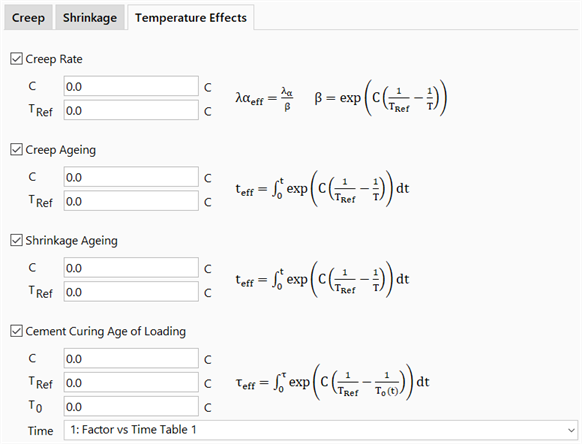Concrete Creep and Shrinkage - Temperature Effects

Description
Concrete Creep and Shrinkage behaviour is heavily influenced by the age or maturity of the concrete. The "effective" age or maturity of concrete can be hastened or slowed due to temperature effects. The Temperature Effects tab is used to specify parameters that account for the temperature effects on the age of concrete as well as on the concrete creep rate.
Note that temperatures are scaled to absolute units (e.g., Kelvin, depending on the model units) when calculating temperature effects on the creep parameters of concrete. The model itself need not be set up in absolute temperature units, but the coefficients must be consistent with the selected temperature units of the model.
Creep Rate
If set, the retardation times for the Kelvin chain model (Concrete Creep: Generalised Kelvin Chain) or the relaxation times for the Maxwell chain model (Concrete Creep: Generalised Maxwell Chain), are modified according to the equation, with the following coefficients:
is a constant (in units of temperature) that specifies the extent to which the temperature modifies the age or maturity of concrete.
is a reference temperature to which the temperatures in the model are compared when determining their effects on the concrete creep rate.
is the nodal temperature.
is the retardation time for Kelvin chain models, or the relaxation time for Maxwell chain models, in a unit
of the viscoelastic chain.
is the effective retardation or relaxation time in a unit
of the viscoelastic chain.
Creep / Shrinkage Ageing
If set, the age of concrete for creep or shrinkage is modified according to the equation, with the following coefficients:
is a constant (in units of temperature) that specifies the extent to which the temperature modifies the age or maturity of concrete with respect to its creep or shrinkage behaviour.
is a reference temperature to which the temperatures in the model are compared when determining their effects on the effective age of the concrete.
is the nodal temperatures.
is the effective age or maturity of the concrete with respect to its creep or shrinkage behaviour.
Cement Curing
If set, the age of loading, , during the curve fitting of the hyperbolic law to either a generalised Kelvin chain (Creep function) or a generalised Maxwell chain (Relaxation function), are modified according to the equation, with the following coefficients:
is a constant (in units of temperature) that specifies the extent to which curing temperatures modify the ages of loading.
is a reference temperature to which curing temperatures are compared when determining the curing temperature effects on concrete creep.
is the curing temperature. This curing temperature can be set to vary with time by assigning a Factor vs Time table.
is the age of concrete at loading (in days) adjusted due to curing temperature effects.
Cement curing is only available for the Hyperbolic Law.
See Also